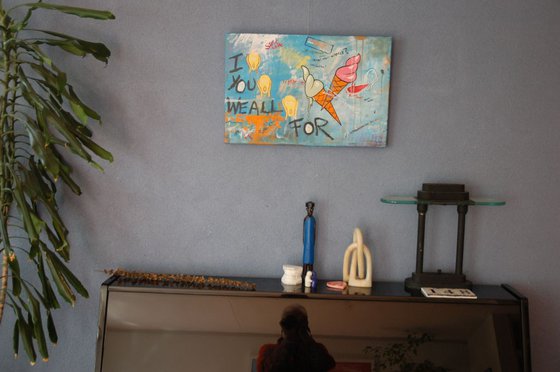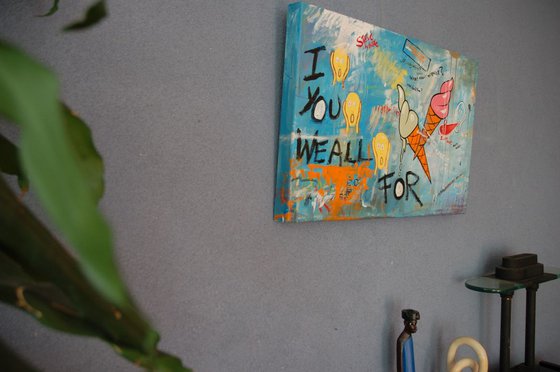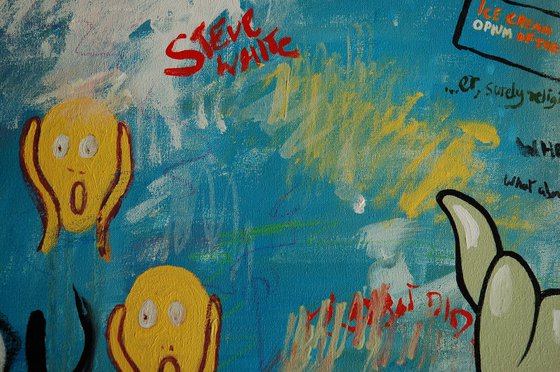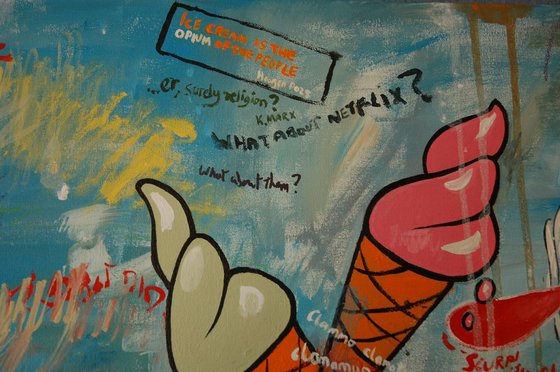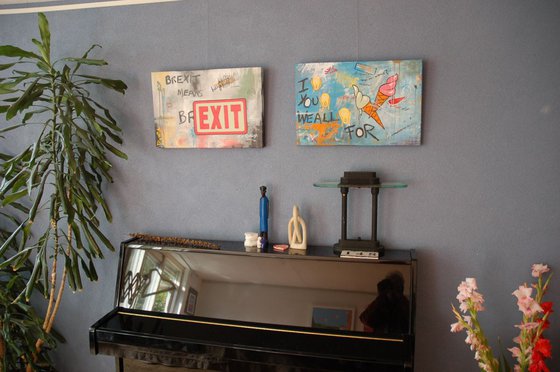- By medium
- By subject
- By budget
- Sales
- Gift cards
- Discover all art
- Artists
- Editors’ picks
- Ideas
Original artwork description:
Is graffiti art? Or vandalism? Or both?
Graffiti - plural of graffito - comes from the Italian word graffiato (scratched) via the Latin 'graphire' and Greek 'graphein,' both meaning 'to write'. The term graffiti originally referred to the inscriptions found scratched on the walls of ancient sepulchres or ruins in the Catacombs of Rome or Pompeii. Use of the word has evolved to include any graphics applied to surfaces in a manner that constitutes vandalism.
Graffiti can can be advertising, social commentary, gangs marking out their territory like wolves urinating on tree trunks, frustrated artists looking for an audience etc etc.
The first known example of modern style graffiti was carved into a wall in Ephesus (modern day Turkey) and comprised a hand print resembling a heart, a footprint, a number and a woman's head. It was advertising a local brothel. The hand apparently reminding you that you had to pay money.
Graffiti can be powerful persuasive tool. In my lifetime one of the most famous graffiti campaigns ever mounted attempted to overturn the conviction of an armed robber from Kent called George Davies. Graffiti sprang up everywhere proclaiming that 'George Davies is Innocent.' Although rightly convicted for later armed robberies Davies was innocent of the raid on the London Electricity Board offices in Ilford Essex in 1974, for which the campaign was mounted. 'George Davies is Innocent' was ubiquitous. Everyone in the UK had heard of George Davies, even if most people didn't know who the hell he was, and cared about him even less. He was not a good person. Davies was released in 1976 and his conviction for the LEB robbery was quashed in 2011.
'Kilroy Was Here' - accompanied by a line drawing of a man with a long nose peering over a wall - was another graffito that wormed its way into people's consciousness and hung around for years like a bad smell. There was no apparent reason for this because no one seems to know who 'Kilroy' was or what he was doing 'there'. It seems to have some association with GIs in the 1940s.
'Clapton is God' was spray painted onto the wall of Islington Underground station by a fan. This probably wouldn' t have become famous graffito itself if it had not been photographed with a dog urinating beneath it. The photograph became an iconic image although Eric Clapton himself thinks it was all a publicity stunt for a concert he was performing in.
Stencil graffiti is a 21st century phenomenon utilised by proponents such as Blek le Rat, Jef Aerosol, Speedy Graffito, Mis Tic and, of course, our very own, Banksy. Cutting stencils from stiff material/card in the safety of one's home means that an image can be produced outside very quickly, reducing the threat of being caught.
Graffiti is art! Absolutely it is. Not only that but it can be Literature/Entertainment too. It might not be so ridiculous to say that you may have come across famous sayings such as 'Knowledge is Power' or 'I think therefore I am' written by some wag on a wall near your local Tescos. Some of the funniest graffiti I have come across was on the wall of the gents toilets in the library of Portsmouth Polytechnic way back in the 70s.
And Industrial/Shabby chic is hot right now! Who doesn' t want a nice bit of controlled graffiti on their wall?!
(If you have a favourite saying/family motto/message you want graffiti-ied don't hesitate to contact me through Artfinder to discuss your needs.)
Limited Edition Prints.
Printed on William Turner Hahnemuhle fine art exhibition quality paper (310 g/m2) using Epson Ultrachrome Pro Pigments, the colours remain true to the original up to 100 years.
The image size is 30×45.3 cms and there is an additional 3 cms border all the way round the image (ie total size: 36×51.3 cms). The artist will sign and number the print in this border. The print is unframed.
Prints will leave the artists studio within 7 days, rolled in a heavy tube, accompanied by a Certificate of Authenticity and sent via track and trace.
Materials used:
Acrylics, pastels
Tags:
#graffiti art #graffiti on canvas #ice cream cone #the scream #edvard munchGraffiti #1: I scream, you scream, we all scream for ice cream. (2018) Acrylic painting
by Steve White
2 Artist Reviews
£215.8 Sold
- Acrylic painting on Canvas
- One of a kind artwork
- Size: 60 x 40 x 4cm (unframed) / 60 x 40cm (actual image size)
- Ready to hang
- Signed on the front
- Style: Urban and Pop
- Subject: Architecture and cityscapes
Do you like this artwork?
This artwork has sold, but the artist is accepting commission requests. Commissioning an artwork is easy and you get a perfectly personalised piece.
Loading
Original artwork description
Is graffiti art? Or vandalism? Or both?
Graffiti - plural of graffito - comes from the Italian word graffiato (scratched) via the Latin 'graphire' and Greek 'graphein,' both meaning 'to write'. The term graffiti originally referred to the inscriptions found scratched on the walls of ancient sepulchres or ruins in the Catacombs of Rome or Pompeii. Use of the word has evolved to include any graphics applied to surfaces in a manner that constitutes vandalism.
Graffiti can can be advertising, social commentary, gangs marking out their territory like wolves urinating on tree trunks, frustrated artists looking for an audience etc etc.
The first known example of modern style graffiti was carved into a wall in Ephesus (modern day Turkey) and comprised a hand print resembling a heart, a footprint, a number and a woman's head. It was advertising a local brothel. The hand apparently reminding you that you had to pay money.
Graffiti can be powerful persuasive tool. In my lifetime one of the most famous graffiti campaigns ever mounted attempted to overturn the conviction of an armed robber from Kent called George Davies. Graffiti sprang up everywhere proclaiming that 'George Davies is Innocent.' Although rightly convicted for later armed robberies Davies was innocent of the raid on the London Electricity Board offices in Ilford Essex in 1974, for which the campaign was mounted. 'George Davies is Innocent' was ubiquitous. Everyone in the UK had heard of George Davies, even if most people didn't know who the hell he was, and cared about him even less. He was not a good person. Davies was released in 1976 and his conviction for the LEB robbery was quashed in 2011.
'Kilroy Was Here' - accompanied by a line drawing of a man with a long nose peering over a wall - was another graffito that wormed its way into people's consciousness and hung around for years like a bad smell. There was no apparent reason for this because no one seems to know who 'Kilroy' was or what he was doing 'there'. It seems to have some association with GIs in the 1940s.
'Clapton is God' was spray painted onto the wall of Islington Underground station by a fan. This probably wouldn' t have become famous graffito itself if it had not been photographed with a dog urinating beneath it. The photograph became an iconic image although Eric Clapton himself thinks it was all a publicity stunt for a concert he was performing in.
Stencil graffiti is a 21st century phenomenon utilised by proponents such as Blek le Rat, Jef Aerosol, Speedy Graffito, Mis Tic and, of course, our very own, Banksy. Cutting stencils from stiff material/card in the safety of one's home means that an image can be produced outside very quickly, reducing the threat of being caught.
Graffiti is art! Absolutely it is. Not only that but it can be Literature/Entertainment too. It might not be so ridiculous to say that you may have come across famous sayings such as 'Knowledge is Power' or 'I think therefore I am' written by some wag on a wall near your local Tescos. Some of the funniest graffiti I have come across was on the wall of the gents toilets in the library of Portsmouth Polytechnic way back in the 70s.
And Industrial/Shabby chic is hot right now! Who doesn' t want a nice bit of controlled graffiti on their wall?!
(If you have a favourite saying/family motto/message you want graffiti-ied don't hesitate to contact me through Artfinder to discuss your needs.)
Limited Edition Prints.
Printed on William Turner Hahnemuhle fine art exhibition quality paper (310 g/m2) using Epson Ultrachrome Pro Pigments, the colours remain true to the original up to 100 years.
The image size is 30×45.3 cms and there is an additional 3 cms border all the way round the image (ie total size: 36×51.3 cms). The artist will sign and number the print in this border. The print is unframed.
Prints will leave the artists studio within 7 days, rolled in a heavy tube, accompanied by a Certificate of Authenticity and sent via track and trace.
Materials used:
Acrylics, pastels
Tags:
#graffiti art #graffiti on canvas #ice cream cone #the scream #edvard munch14 day money back guaranteeLearn more

